When exploring the outdoors becomes challenging due to mobility issues, you don’t have to stay indoors. All-terrain wheelchairs can transform your experience, letting you navigate rough paths, grassy parks, and uneven surfaces with confidence. Whether you’re looking for something lightweight like the Fenetic Wellbeing Voyager or a versatile option like the 2-in-1 Rollator Walker, the right choice depends on your specific needs and lifestyle. Let’s discover which of these top-rated models might become your perfect outdoor companion.
Fenetic Wellbeing Voyager MAG Lightweight Bariatric Transport Wheelchair
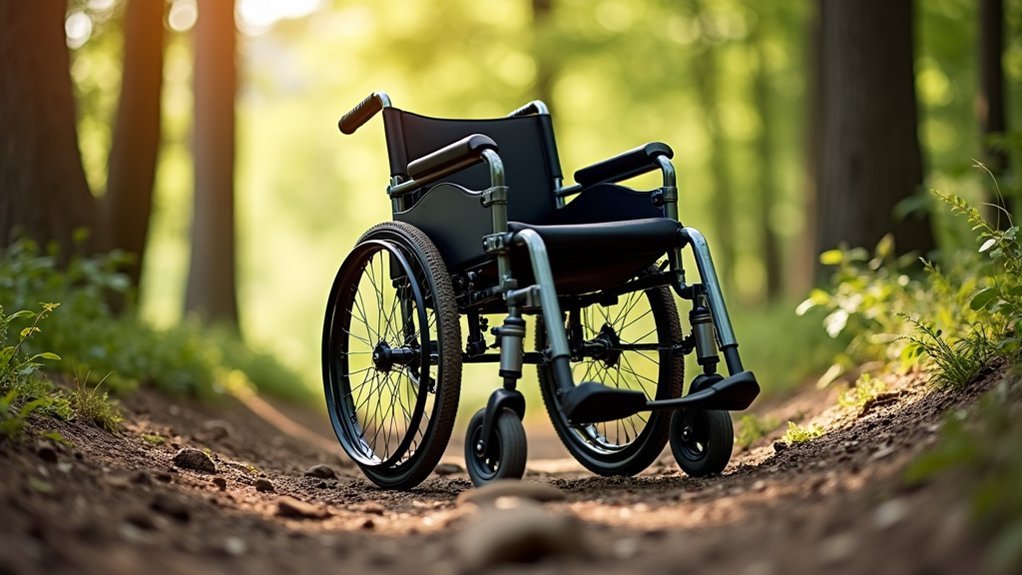
Adventure seekers with mobility challenges will find the Fenetic Wellbeing Voyager MAG an exceptional companion for diverse terrain exploration. This 38-pound wheelchair supports users up to 300 pounds while conquering grass, dirt, and cobblestones with its 24″ pneumatic Mag wheels.
You’ll appreciate the built-in handbrakes for downhill control and safety features like lapbelts and calf straps. The cushioned seat provides superior comfort for extended outings, while drop-down armrests make transfers easier.
For best performance, consider upgrading to Slime Extra Strength inner tubes—a common recommendation from satisfied users who’ve experienced newfound freedom with this sturdy yet lightweight mobility solution.
Best For: Individuals with mobility challenges who need a durable, all-terrain wheelchair for both indoor and outdoor adventures, particularly those weighing up to 300 pounds who desire independence and comfort during extended use.
Pros:
- Versatile 24″ pneumatic Mag wheels provide excellent traction on various terrains including grass, dirt, and cobblestones
- Thoughtful safety features including attendant handbrakes, lapbelt, and calf strap ensure secure positioning on slopes and uneven surfaces
- Lightweight design (38lb with wheels, 22lb without) makes it easier to transport and lift into vehicles compared to standard bariatric wheelchairs
Cons:
- Original inner tubes may be prone to flats and often require replacement with higher quality alternatives
- Limited instructions for folding/unfolding can create initial frustration for new users
- At 22″ wide (standard model), it may be too large for navigating through narrower doorways or tight indoor spaces
Drive Medical Blue Streak Wheelchair for Adults and Seniors
The Drive Medical Blue Streak Wheelchair strikes an impressive balance between durability and portability at just 41 pounds. You’ll appreciate how it folds to a slim 12.5 inches for easy transport and storage in your vehicle.
This wheelchair features an 18-inch padded seat, swing-away footrests, and flip-back desk arms that facilitate transfers. Its blue-powdered steel frame supports up to 300 pounds while solid rubber tires provide smooth maneuverability through doorways.
Assembly requires minimal effort—simply attach the footrests without tools. Users consistently praise its sturdiness, comfort, and ease of use, particularly for seniors or those recovering from surgery.
Best For: Seniors, adults with mobility limitations, and individuals recovering from surgery who need a lightweight, portable wheelchair that’s easy to maneuver and transport.
Pros:
- Lightweight (41 pounds) with a foldable design that compresses to 12.5 inches wide for easy transport and storage
- Comfortable 18-inch padded seat with convenient features like flip-back desk arms and swing-away footrests that require no tools for assembly
- Durable steel frame supports up to 300 pounds with solid rubber tires that provide smooth maneuverability
Cons:
- Some users report issues with small front wheels and armrest release mechanisms potentially affecting long-term durability
- Lacks additional accessories like cup holders or anti-tip legs that would enhance functionality
- May require adjustments for optimal comfort as some users experienced variations in product features
Lightweight Ergonomic Transport Wheelchair for Seniors and Adults
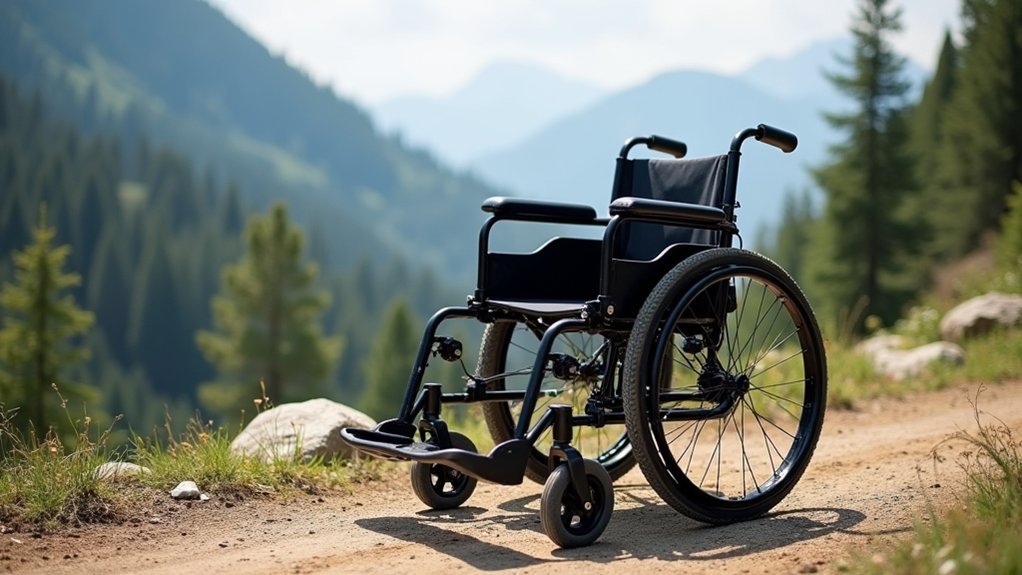
Weighing just 20 pounds, this ultra-portable transport wheelchair offers seniors and adults with mobility challenges a perfect balance of comfort and convenience. The honeycomb wheels—5-inch front swivels and 11-inch solid rear wheels—handle various terrains smoothly.
You’ll appreciate the 280° adjustable armrests for easy access and the telescopic handle that hides under the seat when not needed. The slightly cushioned seat enhances comfort during use.
It folds compactly (33 x 22 x 14 inches) and fits easily in car backseats. While ideal for elderly and pregnant women, taller individuals may find it limiting.
Best For: Seniors, pregnant women, and individuals with mobility limitations who need a lightweight, portable wheelchair for travel and everyday use.
Pros:
- Ultra-lightweight design at only 20 pounds makes it easy to transport and maneuver
- Folds compactly to fit in car backseats with convenient telescopic handle for transportation
- Features 280° adjustable armrests and honeycomb wheels that handle various terrains smoothly
Cons:
- May not be suitable for taller individuals due to size limitations
- Footrest design could be improved for users with significant mobility issues
- Some concerns about brake reliability that may require upgrades or adjustments
Medline Lightweight Foldable Transport Wheelchair with Handbrakes
Designed for users needing assistance on relatively even terrain, the Medline Lightweight Foldable Transport Wheelchair strikes an impressive balance between portability and durability. Weighing just 26 pounds with a 300-pound capacity, it’s ideal for everyday transportation needs.
You’ll appreciate the hand brakes and rear-wheel locks for enhanced safety. The 12-inch rear wheels navigate tight spaces smoothly but aren’t suitable for rough terrain. It arrives fully assembled and folds compactly for car storage.
While not made for self-propulsion or off-road use, you’ll find this wheelchair comfortable for shorter trips, though some users recommend adding extra cushioning.
Best For: Elderly individuals or patients with limited mobility who need a lightweight, portable wheelchair for short trips and indoor use on flat surfaces, with someone available to push them.
Pros:
- Extremely lightweight (26 lbs) with easy folding mechanism, making it convenient for transport and storage in car trunks
- Enhanced safety features including hand brakes and rear-wheel locks for caregivers
- Arrives fully assembled with a solid 300 lb weight capacity despite its lightweight aluminum frame
Cons:
- Not designed for self-propulsion, requiring someone else to push the wheelchair
- Some users report the need for additional seat padding for extended comfort
- Limited to smooth, flat surfaces and not suitable for rough terrain or outdoor adventures
Rollator Walker for Seniors, 2-in-1 Walker Wheelchair Combo with Seat
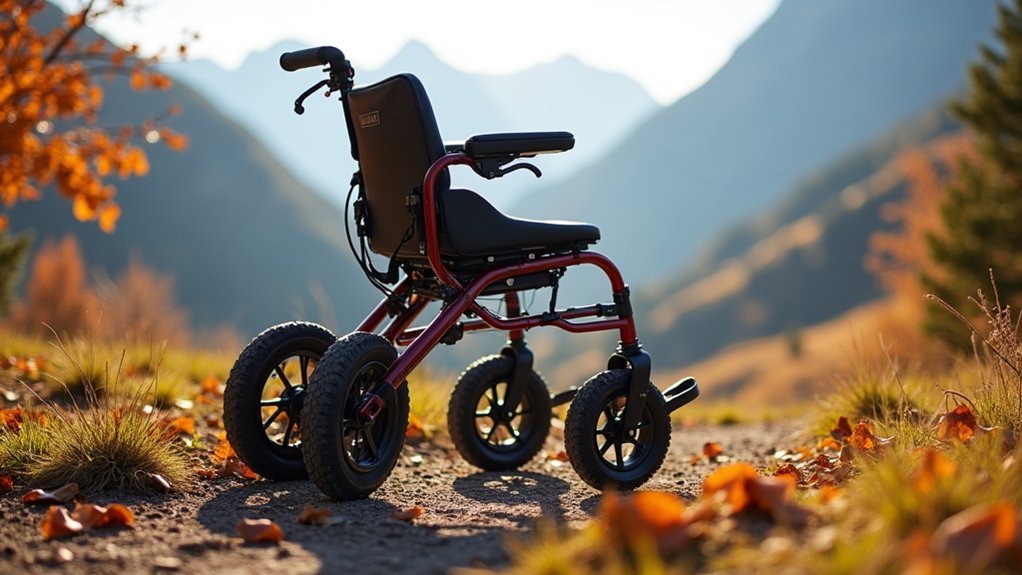
Versatile mobility solutions become essential when you’re traversing diverse terrains while needing occasional rest. The VOCIC 2-in-1 Rollator-Wheelchair Combo delivers this flexibility with its 300-pound capacity and convertible design.
You’ll appreciate the non-inflatable rubber wheels that handle various surfaces and the one-hand folding mechanism that makes storage effortless. The adjustable handlebars and extended backrest offer personalized comfort, while the included pouch keeps essentials accessible.
Though slightly heavy at 26.7 pounds, this FSA/HSA-eligible device balances functionality with convenience. Its 24-inch width navigates most doorways, making it practical for both indoor and outdoor adventures.
Best For: Seniors and individuals with mobility challenges who need the flexibility of both a walker and wheelchair in one device, particularly those who travel frequently or need to navigate various environments.
Pros:
- Versatile 2-in-1 design functions as both a walker and transport chair, eliminating the need for multiple mobility devices
- Substantial 300-pound weight capacity with durable non-inflatable rubber wheels that perform well on various surfaces
- Convenient one-hand folding mechanism and adjustable features make it practical for travel and personalized comfort
Cons:
- Relatively heavy at 26.7 pounds, which may be challenging for some users to lift when storing or transporting
- Some users reported difficulties navigating uneven surfaces and transitions between different terrains
- Assembly can be complicated by non-interchangeable wheel fittings, and some users noted issues with seat comfort
Factors to Consider When Choosing All-Terrain Wheelchairs
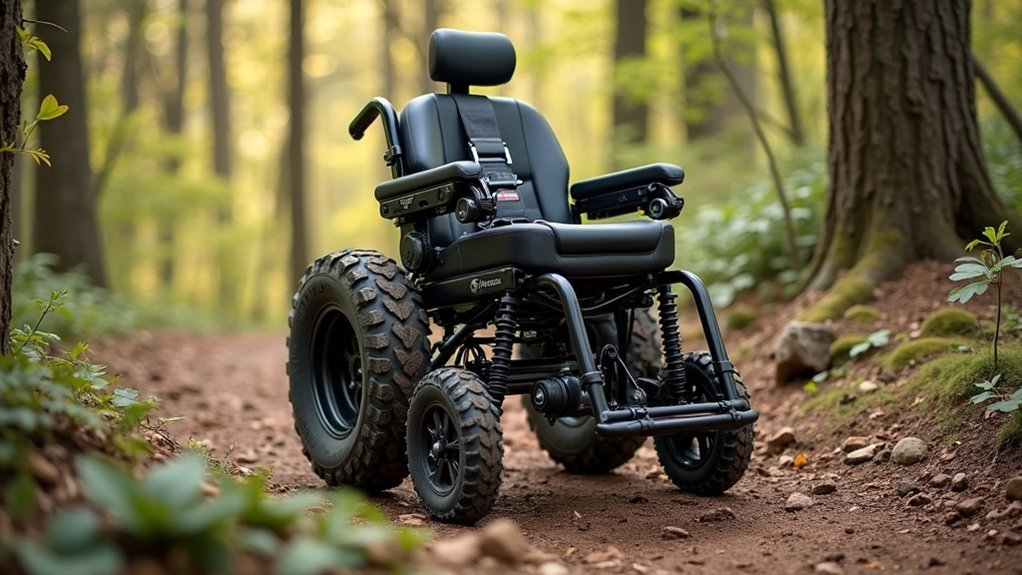
When shopping for an all-terrain wheelchair, you’ll need to evaluate several critical factors to guarantee it meets your specific needs. Your decision should account for wheel type and size, weight capacity, frame durability, and folding capabilities for transportation. These considerations will help you select a wheelchair that offers the right balance of mobility, comfort, and practicality for your outdoor adventures.
Factors to Consider When Choosing All-Terrain Wheelchairs
Selecting the right all-terrain wheelchair requires careful consideration of several key factors that will directly impact your outdoor mobility experience. Look for models with larger 24-inch pneumatic tires featuring deep treads, which provide superior grip on grass, dirt, and uneven surfaces.
Weight capacity is vital—choose a wheelchair that comfortably supports your body weight, with many quality options accommodating up to 300 lbs. Frame material matters too; aluminum offers an ideal balance of lightweight portability and structural strength.
Don’t overlook safety features like reliable handbrakes and positioning straps, which are essential when maneuvering slopes. For comfort during extended outdoor adventures, prioritize models with cushioned seating and adjustable footrests that can be customized to your specific needs.
Wheel Type and Size
The wheels serve as the foundation of any all-terrain wheelchair, determining how effectively you’ll navigate challenging outdoor environments. Larger wheels, particularly 24-inch models, deliver superior traction and stability when you’re traversing rough or uneven terrain.
Consider wheel composition carefully: inflatable pneumatic tires provide excellent shock absorption and comfort but may puncture, while solid wheels offer durability without maintenance concerns. The treaded design of all-terrain tires greatly enhances grip on varied surfaces.
For peak performance, look for configurations that balance weight distribution—solid rear wheels paired with smaller front wheels allow you to maneuver through tight spaces while maintaining stability. Don’t overlook swivel capabilities in front wheels, as this feature considerably improves your ability to navigate obstacles and change direction on different terrains.
Weight Capacity
Beyond wheel specifications, weight capacity represents a fundamental consideration for all-terrain wheelchair selection. Most models offer between 250-300 pounds of support, so you’ll need to match this to your needs for safe operation.
When evaluating capacity requirements, account for your body weight plus any accessories or personal items you’ll regularly carry. Exceeding the manufacturer’s recommended limit compromises both safety and the chair’s longevity, particularly on challenging terrain.
If you require additional support, look for bariatric models featuring reinforced frames and components specifically designed for higher weight capacities while maintaining stability. Even if you’re well within standard limits, choosing a wheelchair with slightly higher capacity than needed can provide extra durability and reduce wear when traversing rugged landscapes regularly.
Frame Durability
Frame durability stands as the backbone of any reliable all-terrain wheelchair, determining how well it will perform across challenging environments. When evaluating options, you’ll need to take into account the materials used—aluminum offers a lightweight yet sturdy solution, while steel provides superior strength at the cost of added weight.
Look for reinforced joints and cross-bracing in the frame design, as these features prevent bending or breaking when maneuvering uneven terrain. Your wheelchair should have a weight capacity that exceeds your needs, with options typically ranging from 300 to 600 pounds for bariatric users.
Don’t overlook the importance of regular maintenance checks. Inspecting your frame for signs of wear or damage will extend your wheelchair’s lifespan and guarantee your safety during outdoor adventures on dirt, gravel, and grass.
Folding and Portability
When planning outdoor adventures, folding and portability features become essential considerations for your all-terrain wheelchair selection. Look for models with lightweight, compact designs that fold to approximately 12.5 inches or less in width, ensuring they’ll fit easily in your car trunk or storage spaces.
Weight matters considerably—opt for chairs between 20-40 pounds that you or your caregivers can manage comfortably. The best portable options require no tools for assembly, allowing you to prepare quickly for spontaneous outings.
Don’t overlook the value of detachable footrests and collapsible armrests, which enhance folding convenience and overall transportability. These features make a considerable difference when you’re frequently traveling or maneuvering tight spaces, ensuring your wheelchair adapts to your active lifestyle rather than limiting it.
Terrain-Specific Features
The right wheels make all the difference when conquering challenging landscapes in your all-terrain wheelchair. Look for larger 24-inch pneumatic tires with deep treads that provide essential grip on dirt, grass, and cobblestones. These wheels distribute weight more effectively, preventing you from getting stuck in soft surfaces.
Consider how the chair handles slopes and changes. Quality handbrakes give you control on descents, while secure positioning features like lap belts and calf straps keep you safely seated on uneven ground.
The frame material matters too—aluminum offers the ideal balance of durability and lightweight handling. You’ll want adjustable footrests to accommodate changing terrain angles and a cushioned seat that remains comfortable during extended outdoor adventures. These terrain-specific features transform ordinary mobility into true all-terrain capability.
Braking Systems
Reliable braking systems serve as your lifeline when traversing challenging terrains in all-terrain wheelchairs. When evaluating options, look for models featuring built-in attendant handbrakes that provide superior control on slopes and uneven surfaces.
Your ideal wheelchair should include push-to-lock functionality to prevent unwanted movement during transfers. Many high-performance models incorporate manual locking brakes that guarantee stability when stationary, particularly on inclines where safety is paramount.
Consider how you’ll access the brakes—some designs don’t allow seated users to engage brakes independently, which could limit your autonomy. As you compare options, prioritize responsive braking systems that can handle rough surfaces and obstacles. This critical feature will give you confidence to navigate challenging environments while maintaining control and safety throughout your outdoor adventures.
Frequently Asked Questions
How Do All-Terrain Wheelchairs Perform on Beaches and Sand?
All-terrain wheelchairs perform well on beaches and sand with their wide, balloon-like tires that prevent sinking. You’ll enjoy improved stability and maneuverability, though you might need more effort when pushing through deeper sand.
Are All-Terrain Wheelchairs Suitable for Hiking Trails?
Yes, you’ll find all-terrain wheelchairs excellent for hiking trails. They’re designed with wider tires, enhanced suspension, and sturdy frames that handle roots, rocks, and uneven paths with impressive stability and maneuverability.
Can Insurance Cover the Cost of All-Terrain Wheelchairs?
Insurance may cover all-terrain wheelchairs if deemed medically necessary. You’ll need a doctor’s prescription and documentation. Check with your provider, as coverage varies widely and you might need to appeal initially denied claims.
What Maintenance Is Required for All-Terrain Wheelchair Tires?
You’ll need to regularly check tire pressure, clean dirt/mud after use, inspect for damage, and occasionally replace tires when worn. Don’t forget to lubricate bearings and tighten loose spokes as needed.
How Do All-Terrain Wheelchairs Handle Winter Snow Conditions?
All-terrain wheelchairs handle snow with wide, treaded tires that distribute weight and maintain traction. You’ll find models with winterization kits, heated seats, and snow-specific wheels that’ll help you navigate snowy conditions confidently.

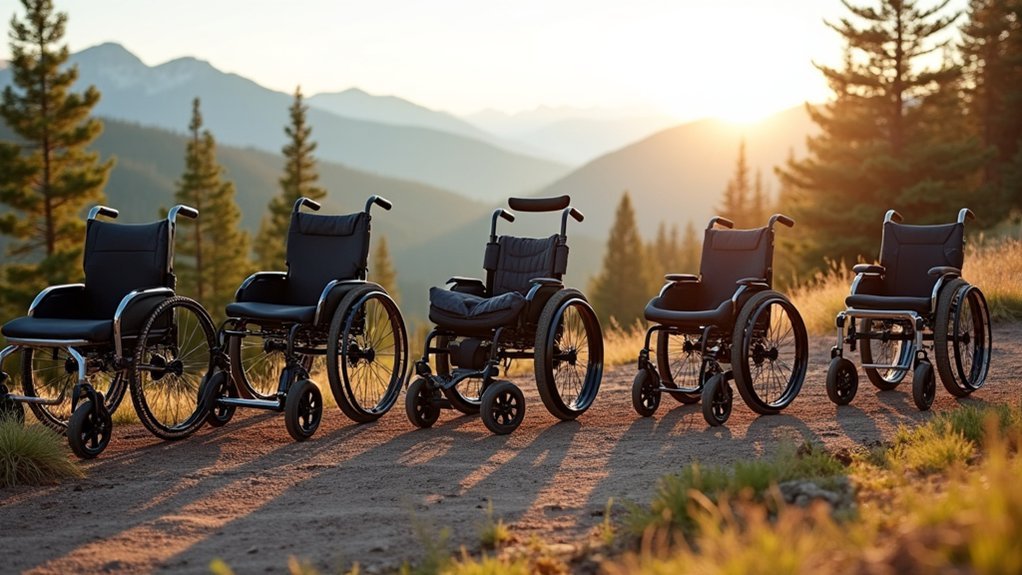



Leave a Reply